

Niah Cave- Exploring cave in Niah National Park (day tour)
Posted on Last updated: August 30, 2023
Categories Sarawak , Visit Malaysia
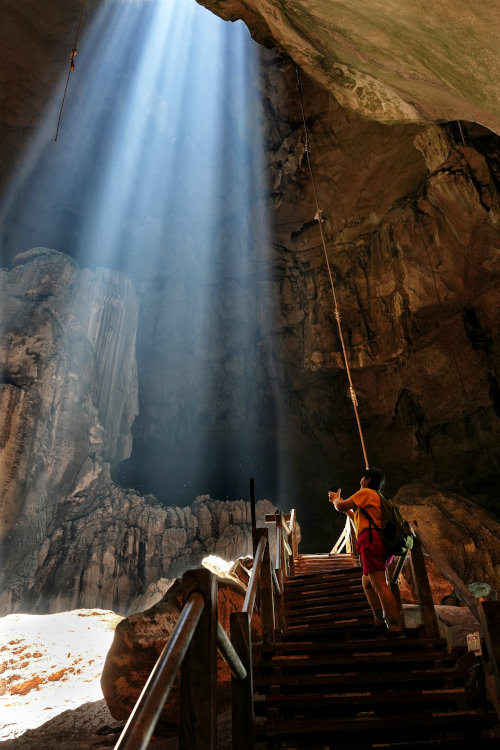
Nearly two decades ago, we visited North Sarawak once, but due to a tight schedule, we could only manage to explore Mulu Cave and Miri. We do not want to miss the opportunity again this time, so we have arranged a day trip with Brighton Travel and Tour to Niah Cave (Gua Niah) tour as part of our Northern Sarawak holiday.
Why are we so interested to visit Niah Cave? We know that Niah Cave is well known for its archaeological significance in the existence of prehistoric man in Island Southeast Asia. And since humans continuously inhabited the cave until the 19th century, there must be something worth seeing.
After a restful night’s sleep in Miri, we headed straight to Niah after breakfast. It is a leisurely drive of about an hour and twenty minutes, and we arrived at the small town of Batu Niah, approximately three kilometers from the Niah Cave.
1. Arriving at Niah National Park Office

Since now is not a holiday season, there were few visitors to the park headquarters.

We completed a simple registration process at the customer service center before taking a short walk to the jetty at Niah River.
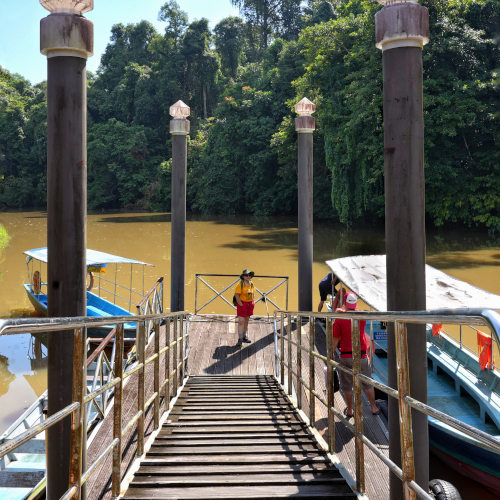
For information on the entrance fee, please refer to the image below.

Our visit included three main caves: the Traders Cave, the Great Cave, and the Painting Cave.

Accommodation options are available at the National Park, ranging from air-conditioned rooms with attached bathrooms to hostel-style rooms. If interested, please visit the national park’s website for more information.

Watch the video ot the best places to visit in Niah Cave (at the end of this article) 👇👇.
2. Some advice before the cave exploration
We are advised to bring a few things Before entering the park.
- A torchlight and spare batteries as we will need them inside the cave.
- Apply insect repellent to protect ourselves from insects.
- A bottle of drinking water to stay hydrated throughout our trip.
- Also, some personal medication and essential first aid items.
- Wear sturdy and comfortable tracking or rubber shoes.
- Lastly, get a raincoat just in case it rains.
Also, please take note of the following:
- Using the toilet before entering the cave is best, as it will be a long walk for a few hours.
- There is also a signboard to remind us to be cautious of snakes while walking on the wooden walkway, as we encountered one.
- Besides, be mindful of bees as I get stung. Although it was not poisonous, it was pretty painful.
- Furthermore, snails are in the park, so we had to watch our steps and avoid stepping on them.
3. Crossing the river

Our adventure officially began as the boatman ferried us across the river. A signboard reminded us of the crocodiles in the river, so please refrain from putting your hands in the water!
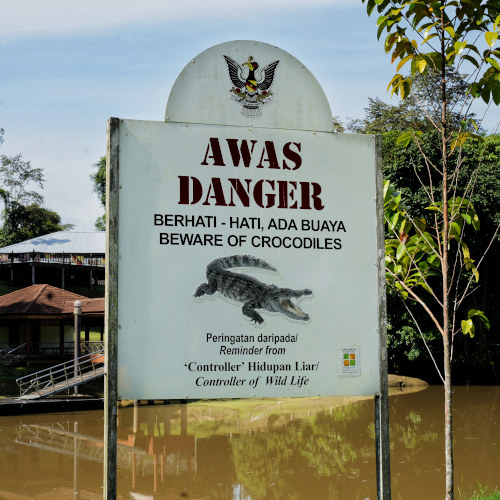
Upon entering the park, a sign indicates the distance from the entrance to the Traders Cave is approximately 2.8 kilometers.

Although it was an easy walk, it was pretty slippery due to mold growth.

There are several gazebos along the boardwalk for visitors to take a break, but we felt fresh and energetic, so we did not have any pit stops.

We encountered a pair of millipedes mating during our walk along the boardwalk, which was fascinating. It appeared they only did the act in the morning, as we no longer saw it on our return trip.

Additionally, we spotted some beautiful red ginger flowers and a hammerhead worm on the boardwalk’s railing. There are also numerous squirrels in the area.

We reached the Tangap Community Craft Center halfway to the Traders Cave. Nevertheless, we did not stop as we were eager to explore the cave.
4. The Traders Cave

Finally, we arrived at the Traders Cave, the first cave, after climbing some wooden stairs.
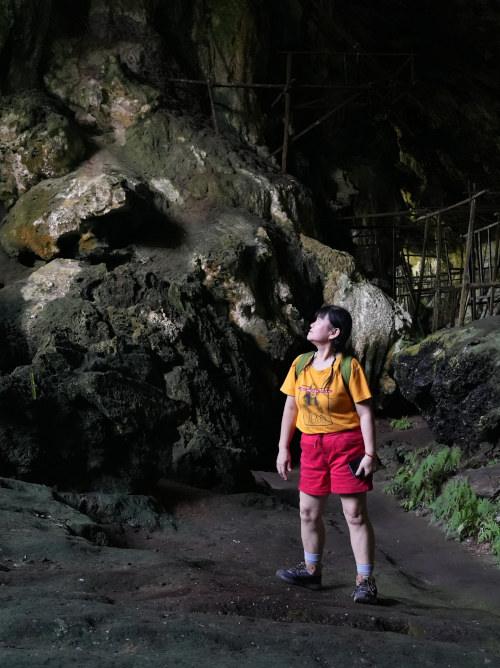
According to the sign board near the entrance, the cave was excavated in the 1950s, with only minimal archeological deposits found. The structures we saw are remains of ancient ‘roofless huts’ made of ironwood or belian. The bird nest collectors and their families constructed and used these huts as shelters during the harvesting seasons.
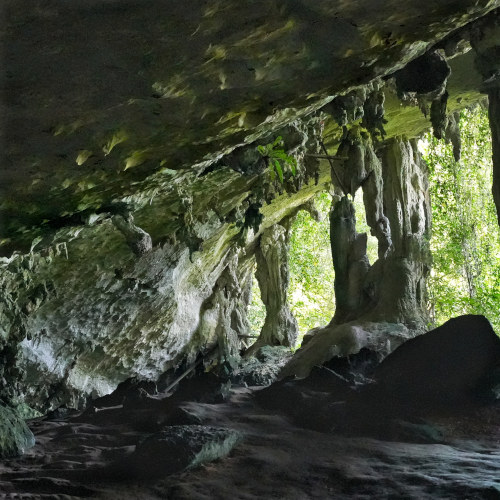
The cave is named for the collectors who sold or traded their harvests in return for products brought to the cave by traders from the towns. These huts were still used until the late 1970s.
The bird nests in this cave are the mossy type, which has no commercial value.
Also are effects of geological weathering on the walls and ceiling, made when this cave was submerged underwater million years ago.
After visiting the Traders Cave, we head towards the Great Cave, just slightly over 300 meters from here.
5. The Great Cave

Before reaching the cave mouth of the Great Cave, we had to climb up a few flights of stairs. The fascinating sights we witnessed were the bamboo and belian (ironwood) poles to harvest the birds’ nests.
Belian (ironwood) is known for its exceptional durability, an ideal construction material. In the past, indigenous people utilized it to construct jetties, wharves, bridges, houses, coffins, and furniture. Nowadays, belian trees are protected in Sarawak, and locating them can be challenging.
We entered the Great Cave through the West Mouth, first explored by AH Everett in the 1880s. Since then, the Niah Cave Project, in collaboration with the Sarawak Museum, has conducted minor excavation activities in the caves.

This location is one of Southeast Asia’s most important archaeological sites because it provides evidence of human habitation for a long period, spanning from 40,000 to 2,000 years ago. Further, this massive cave system has an extensive collection of the oldest human remains. On February 7th, 1958, researchers discovered the earliest proof of Homo sapiens in Island SE Asia in the “Hell Trench,” located 106 to 110 inches below the original ground surface.
Bird nest collectors constructed belian and bamboo poles on the cave roof to collect bird nests. They possess mine-blowing skills to attach these poles to the cave’s ceiling.

It became pitch dark not long after we entered the Great Cave. We switched on our headlamps to navigate and found several crickets on the boardwalk.

Upon reaching the end of the cave, we were met with a vast chamber at Lubang Padang. Luckily, we arrived at the perfect time, and the rays of sunlight shone through the gaping hole in the roof, illuminating the enigmatic formation within. This spot was undoubtedly the most picturesque location during our expedition to the Niah Caves.
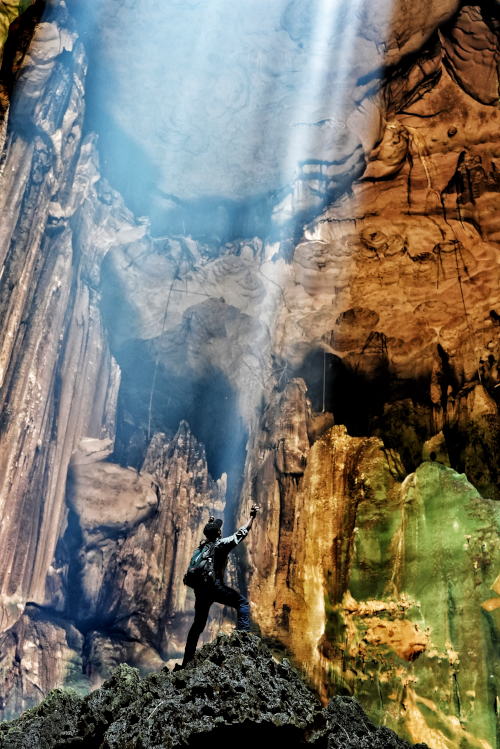
Lubang Hangus is a chamber situated in the Niah Cave. The research found that zooarchaeological records of some sections of the Niah Cave, including the Terminal Pleistocene deposits in Lubang Hangus, indicate that animal foods extensively existed. This showed that Lubang Hangus was crucial for prehistoric human habitation and subsistence.
Tom Harrison, a renowned anthropologist, ethnologist, and archaeologist, led the excavations in the West Mouth of the Niah Cave. Their most significant discovery was a human skull, known as the Deep Skull, found in deposits dating back about 40,000 years ago. This is now recognized as the earliest proof of modern humans in Borneo.
After taking some stunning photographs, we left this place and carried on to Gan Kira and Painting Cave.
6. Gan Kira

After leaving the Great Cave, we entered a stretch of cave with total darkness called Gan KIra. According to our guide, Andy, the word Gan Kira comes from Gang Kira. Kira means to count (money), and here is where the Gang of traders count their profit from collecting the bird nests.
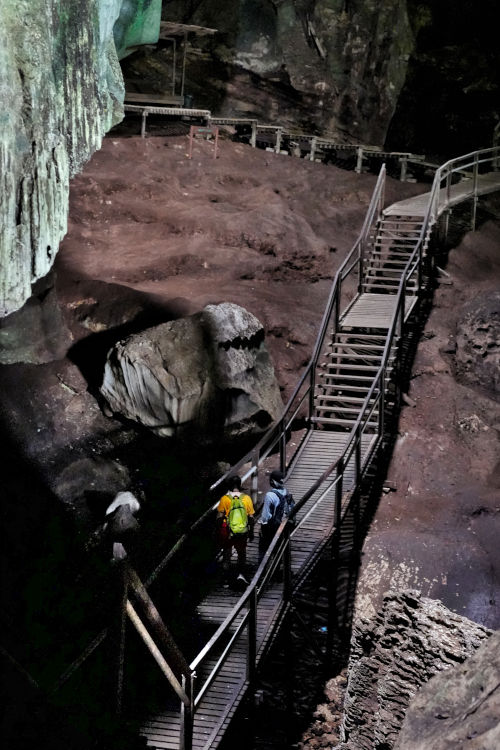
7. Painting Cave

The Painting Cave is a limestone cave about 400 meters from Gan Kira. We left the Gan Kira and walked on a boardwalk outside the cave. Painting Cave is not particularly large, but what makes it fascinating is the prehistoric ancient paintings found inside.
Archaeological excavations have uncovered artifacts such as stoneware, shells, beads, metal items, and pottery, including unique double-spouted vessels.
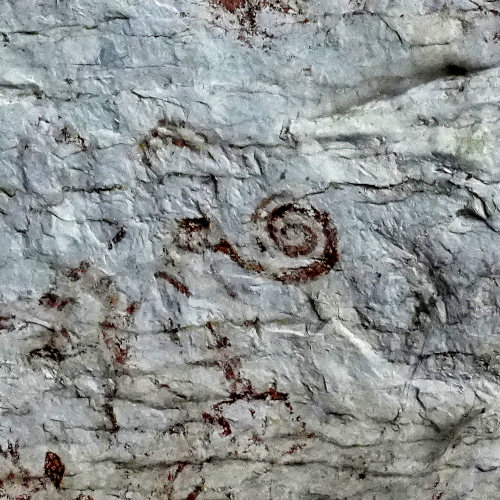
The rock art panels in the cave stretch for almost 50 meters and feature over 100 individual drawings. Each drawing is depicted in red with various sizes, from a few centimeters to one meter. It is believed that the pigment used in the drawings may be hematite or plant dye.

(The boat coffin)
Boat coffins have also been discovered in association with these finds.
The drawings depict boats, human figures, and geometric and abstract designs. These cave paintings and boats may have represented the deceased’s journey to the underworld.
Because the drawings on this painted cave are fragile and deteriorating, the site is fenced off for conservation purposes.
Below is a side-by-side comparison of photos I captured during my recent visit to a cave and a photo taken back in 1959.

8. Lunch at a longhouse in Tangap

Our journey took us through Gan Kira, and we returned to Traders Cave after exploring Painting Cave. I have included more photos we took on our way back.
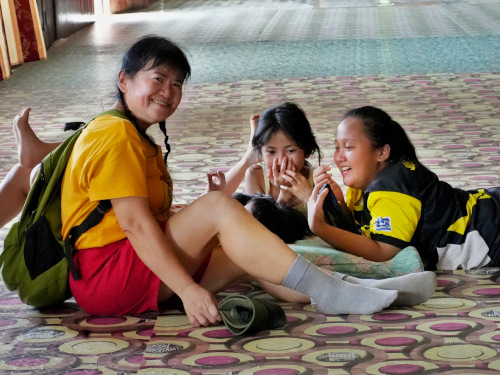
(with children in the longhouse)
We made a stop to have lunch at a longhouse in Tangap. The Iban people kindly served us traditional food. Our day concluded with a return to the National Park entrance and a dinner in Miri.

9. We stopped at Peliau Beach
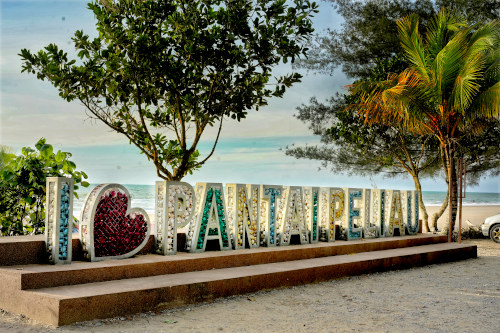
It was already past 5:00 p.m. when we started driving back to Miri. However, we felt it best to pause our journey and appreciate the sunset at Peliau Beach, halfway between Niah and Miri city.

When we arrived, two women were fishing for crabs and fish in the sea.

Our decision proved fruitful as we witnessed the beauty of the sunset at Peliau Beach.
Overall, we have explored various attractions across Malaysia in the past. Still, this experience at Niah Cave in East Malaysia was exceptional due to its prehistoric significance and magnificent cave formation. It was a day well spent. We will also plan to visit Mulu Caves during our holiday, which will be covered in a separate article.
Watch the video we shot at Niah Cave 👇👇.
We also uploaded a video of our trip to Niah Cave. Please click the image below to bring you to our YouTube channel (shot in high definition!). You may also want to check out our hiking trip to Mount Kinabalu and Miri .

Thursday 31st of August 2023
We like to visit Sarawak, we have no time constraints, will be delighted if you can share places you visited .
Tuesday 12th of September 2023
Sure. Please follow this link, which I have listed all my Sarawak articles here: https://travelwithlens.com/category/sarawak/ There are only a few places, but we plan to make another trip to Kuching and the surroundings in December.

Dive Into Malaysia
Niah Caves: Everything You Need To Know About Niah National Park
Niah Caves (or Gua Niah in Malay) is an amazing cave complex with a long history about an hour and a half southwest of Miri in Niah National Park. It’s a popular day trip from Niah or can be visited as part of a bigger exploration of Sarawak. I visited Niah on my way between Miri and Bintulu. It was the perfect half day stop.
Niah Caves Sarawak is famous for being the site of the oldest discovery of human remains in southeast Asia. It’s known that humans lived here over 40,000 years ago. It’s believed people have lived here almost continuously from this time until the 19th century.
It’s also home to rock paintings and the huge Great Cave which is two kilometres long, up to 250 metres across and 60 metres high. It truly is a great cave!

There’s also nice hiking here to the caves along an easy boardwalk, an archaeology museum and it’s a very enjoyable to spend a half day here.
If you have been to Mulu Caves , like I just had when I visited here, you may be wondering if it’s worth going to another cave complex. I can say it definitely is. It’s a different experience visiting the Niah Caves in Sarawak, and I highly recommend it if you have the time.
Below, I share everything you need to know about Niah Caves National Park including how to get here, what you can do when you arrive, what it’s like, the Niah Caves Miri entry price and more. There is a lot to do here and this guide will help you plan your own Niah Caves day trip.
Want to make your visit here extra easy? Book a Niah Caves tour here.
Travelling to Malaysia? Click here to download your free Malaysia Trip Planning checklist . We’ll help you get ready for your trip!
Have any questions? Join our Malaysia Travel Planning Facebook group here now! It’s the perfect place to ask any questions and to be inspired.
Niah Caves Sarawak

Niah Caves are in the Niah National Park, and this is where you are heading for your visit.
The Niah National Park is 3,138 hectares and became a National Historic Monument in 1958, after a 40,000 year old skull was found. It then became a national park in 1975.
In addition to the skull, evidence of human settlement was found with items like tools and cooking utensils made out of stone, clay and bone. This leads archaeologists to believe that this area has been settled since the earliest part of the Stone Age. Evacuation work still continues today.
In addition to the caves, a river flows along the park’s western border and there is a large limestone mountain mass which makes up a big chunk of the park.
Niah National Park Headquarters

On arrival at the park, head straight to the Park Headquarters, buy your tickets and get a Niah Cave map. They will also walk you thought your visit.

After you buy your tickets, head to the building opposite this one where you’ll find the cafeteria, toilets and the boats across to the national park.

The cafeteria is easy to find at the entrance to the building pictured above. I had lunch here after my caves visit and the food was good and cheap.
The best part was the cold drinks though!
Just before the caves, you are also able to buy drinks within the park as well.
Boat To Niah National Park

Once you have bought any last minute supplies and gone to the toilet, keep walking through this building and you’ll soon see the jetty and boats across to the national park.
The only way to get inside the national park is by this boat which costs RM1 each way.

The boat runs on demand, and you shouldn’t wait long. You’re then ready to start your visit!
Niah Archaeology Museum

After you cross the river, the first thing you’ll see is the Niah Archaeology Museum. I read this opens at 9am, but it was open when I arrived here at 8:30am.
It’s worth popping in to give yourself a great background of what you’ll be seeing in Sarawak Niah Caves.

It’s just a small museum, but it’s a good introduction to the site. There are displays on the geology, ecology and archaeology of Niah as well as replicas of the skull that was discovered and an original burial canoe thought to be 1200 years old.
There’s also a great model of Great Cave.
Walking To The Caves

It’s 2.8 kilometres to get to the first of three caves. Once you hit the first cave, the caves are quite close together.

The walk is great. It’s easy and enjoyable with plenty to see through swampy old rainforest. It’s mostly on boardwalk but some is on a concrete path. It’s in great condition and wasn’t slippery when I visited. I walked this in about half an hour.
It can get slippery after rain though, so be careful and wear shoes with good grip.
You may be able to spot birds, monkey and butterflies.

Not long before the first cave, Traders’ Cave, is a toilet block and some stalls selling drinks, snacks and handicrafts.
Traders’ Cave

Traders’ Cave is where birds nest collectors and guano (bat and bird poo) traders used to conduct business.
It’s not really a cave and resembles a rocky overhang. You’ll know you’re here when you see the scaffolding and the remains of huts where the bird nest collectors used to live up until the 1970s.

It’s quite different walking through here compared to the path in the lead up. It’s quite an experience and, in some ways, more picturesque than the other caves thanks to more light.

Just before the cave is the first steps of the trail too, but there will be more inside the caves.

Keep walking for a few minutes, and you’ll come to the Great Cave. As mentioned above, this cave is huge.
This cave is where the 40,000 year old skull was found, so it’s an important archaeological site. As you enter, get your torch ready. You’ll need it!

At the entry to the cave, there are two options of where to walk. It’s confusing as it’s really hard to see one of them, the one you are supposed to take.
This path is on the left and actually involves walking up along the fence which doesn’t seem like a path at all. It will lead to a boardwalk though and avoids you backtracking on some of the path in this cave.

You can walk along here and it’ll join the other path about midway through.
If you find this confusing and end up on the main path pictured above instead, just be careful when the paths join again that you turn RIGHT and NOT left. I initially thought this intersection was where I was meant to turn left and then realised I was heading back to the beginning.
I met someone at the park who did the same thing, but he didn’t realise he had gone the wrong way and ended up missing out on the Moon Cave and Painted Cave. It’s a shame they don’t signpost which way to go.
On your way back through, you will take the other path out.

These first parts are not pitch black, and there is some light around, but you’ll still want a torch to explore here as there is a lot to see in this dark cave with many great rock formations. There are some places where there are holes in the top of the cave and light streams through which are extra pretty.

About 15 minutes after entering the cave, I reached the dark passage known as Moon Cave (Gan Kira). There is a strange moon-like feel to the cave with craters and all the guano.
It’s also completely dark in places. You’ll be fine if you stick to the path but you do need a (very good) light with you.
Things can be slippery in here thanks to guano on the path. I had to walk very slowly and still slipped a little at times. There is a handrail in parts, but it was absolutely covered in webs so I didn’t want to touch it. There are some narrow steps and bigger ones at times too.

I saw quite a few huge spiders on the ground in front of me, huge cockroaches and things jumping around which looked like huge black grasshoppers. There was also a sound that was just like Predator from those old horror movies 😮
It took me about 10 minutes to walk through this cave, and I would be lying if I said I wasn’t terrified. I was alone (which I don’t recommend) and my mind was having lots of fun imagining things that scared the $hit out of me.

At the exit of the cave is an ancient burial site. There are some signs here but nothing to see anymore.
Painted Cave

From here, it’s another 420 metres through the rainforest on a raised boardwalk to Painted Cave.

This cave is famous for its ancient paintings (around 1200 years old) and old boat coffins were found here.
The pictures show animals, humans and the dead souls being taken to the afterlife via boats. The paintings are fenced off and hard to see as they have deteriorated over time. I couldn’t see them at all.

From here, you need to walk back to the boat to Park Headquarters following the way you came. The only difference is that in the Great Cave, you can go to the left to take the path you didn’t take on the way through.
The worst part is having to walk through Moon Cave again. Which I again found terrifying!
All up, the walking through the caves and to and from them took me about three hours. I didn’t rest, but took lots of photos.
Bukit Kasut

If you have the time, it’s also possible to walk to the summit of Bukit Kasut. This is 205 metres high and takes about 45 minutes on a boardwalk through a freshwater swamp forest.
I didn’t do this walk. It’s meant to be a little steep and can get quite slippery. It was also shut when I visited.
This walk starts not far from the museum and is clearly signposted.
Where Is Niah Caves?
Address: Niah National Park, Miri, Sarawak
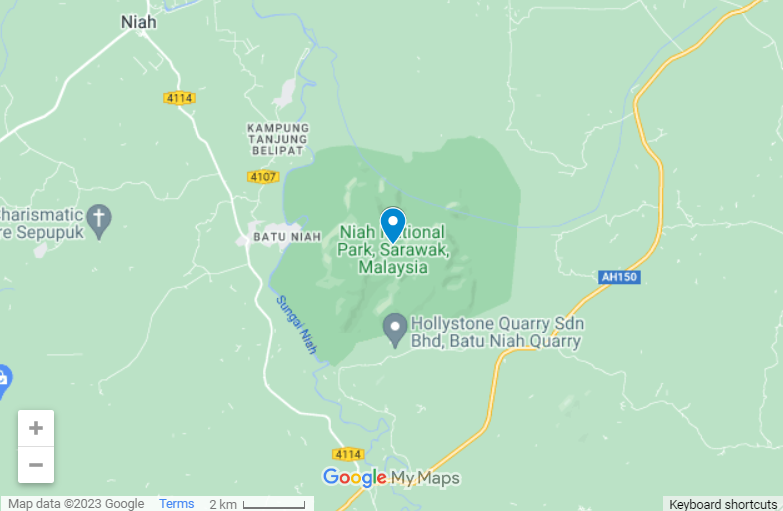
Niah Cave Malaysia is located in Niah National Park about 83 kilometres southwest of Miri. It is near the town of Batu Niah which is the town to head for if you are bussing here.
The easiest way to visit is on a Niah Cave tour.
Click here for prices and options now.
It’s also possible to visit independently. I hired a car in Miri and drove to Niah Caves for my visit here which is straightforward. Look for the brown signs for “Taman Negara Niah”. There is free parking by the Park Headquarters.
You can also hire a taxi or get a bus. For a bus, get one going to Batu Niah. From where the bus drops you, it’s 5.6 kilometres to the national park entrance so you need to take a taxi for this final part of the journey. You can use Grab to get a taxi. To return afterwards, you can ask for help getting a taxi at the National Park Headquarters but this may be tricky.
Click here for our full guide to getting to Niah Caves from Miri.
Niah Caves Opening Hours
Niah Cave Borneo is open from 8am to 3pm daily for day visitors. If you are staying overnight, you can access the park from 8am to 5pm.
I was glad I arrived early at about 8:30am as it only gets hotter and busier. I passed a few tour groups on my way and it was much busier. I’m guessing most people arrive about 10:30am.
Niah Caves Ticket Prices

There is no separate charge to visit Niah Caves Malaysia, the museum or anything else. You pay for Niah National Park entry only.
The Niah entry price varies depending on whether you are Malaysian or not. MyKad holders pay RM10 for adults, RM5 for 60+ year olds and RM3 for 6 – 17 year olds. The rest of us pay RM20 for adults and RM7 for kids.
You buy your tickets at the Niah National Park Headquarters. After you have these, you need to cross the river behind this building into the park and the boardwalk to the caves. This is by motorised boat, and it costs an extra RM1 per person each way.
Niah Caves Accommodation

If you wish to stay overnight, this is easy at the on-site accommodation ran by the Niah National Park Headquarters.
There are clean and comfortable rooms with air-conditioning and private bathrooms or cheaper beds in a hostel bunk room. You can also camp here or participate in a homestay in a traditional 100-door longhouse.
You can find online booking for this accommodation and more information here .
Final Words
The Niah Caves Borneo are an excellent place to visit when you’re travelling round Sarawak or if can spare some time in Miri. It’s a great place to explore the great outdoors, walk through some magnificent caves and learn more about the history of humanity.
You only need a few hours to have a great visit here so try to fit it in if you can. I really enjoyed this national park. The hiking was relatively easy and the caves great. Although, I did freak myself out in the Moon Cave. It would be better to visit here with someone else for sure!
If I went back by myself, I would turn around and head back at the entrance of Moon Cave. I can still hear the Predator sounds when I think about it!!
Make sure you take a torch/head lamp/flashlight, water, sunscreen, hat and wear great shoes.
Book your Niah Cave day tour here.
Looking for other things to do in Miri? Find our full guide here . You can also find our full guide to where to stay in Miri here and our full guide to Miri here . Also, consider visiting Lambir Hills National Park here.
Planning a trip to Malaysia? Have any questions? Join our Malaysia Travel Planning Facebook group here now! It’s the perfect place to ask any questions and to be inspired!
Related posts:
By Sharon Gourlay
Sharon is a certified Malaysia travel expert and can't get enough of travelling and talking about Malaysia since she first visited 21 years ago. She travels around Malaysia multiple times a year both alone and with her kids. She used to call Penang home and especially loves this food paradise. Sharon also has a Bachelor of Arts in Asian Studies, a Certificate III in International Travel Sales and has been certified by Tourism Malaysia as a Malaysia Travel Expert. Through this site, she'll help you have the perfect trip to this amazing destination.


A Singaporean's Adventures at Home and Abroad
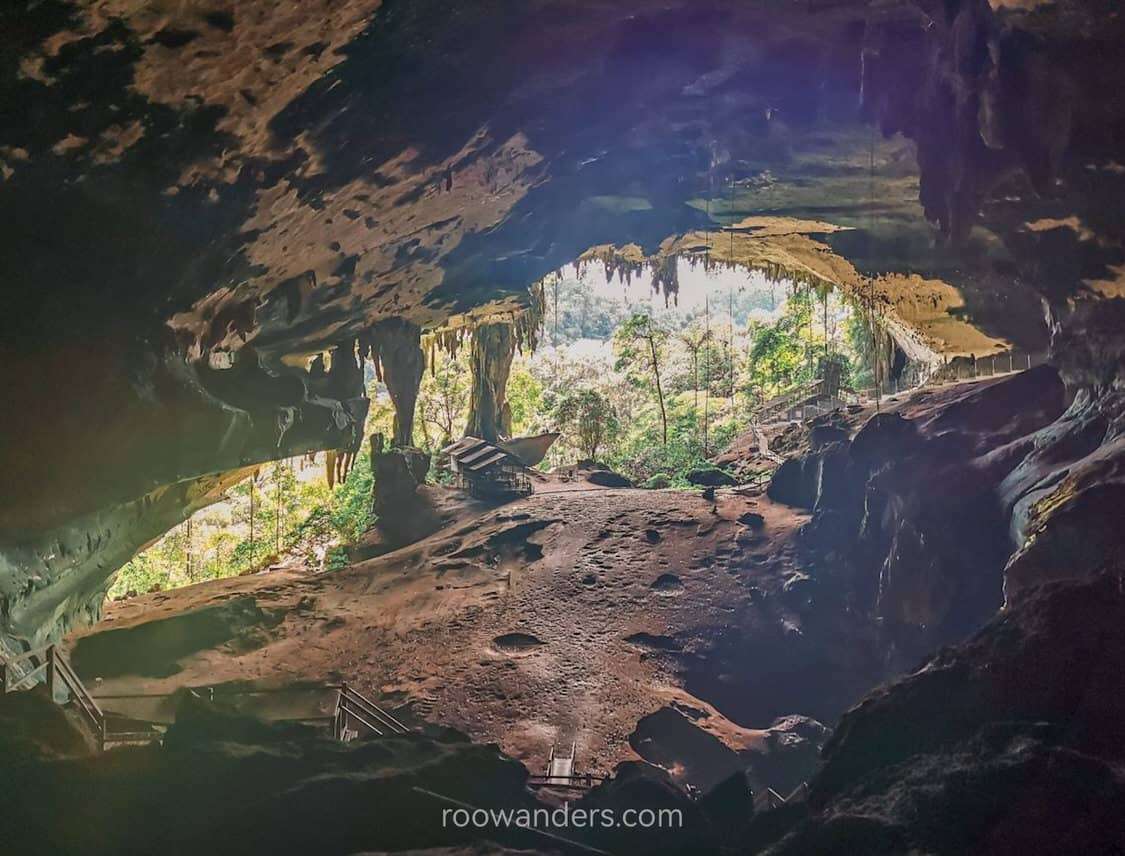
Exploring Gua Niah: The Impressive Cave of Miri
Gua Niah, or Niah Cave, is a rather secluded cave accessible from Miri, Sarawak, on the Malaysian side of Borneo island.
A perfect climate for rich biodiversity, Borneo, the third largest island in the world is home to three countries – Malaysia, Brunei and Indonesia.
My travel buddy and I decided to visit the Malaysian side of Borneo on a whim at the beginning of July, and the trip materialised less than a fortnight later. On our list were diving in Miri , visiting the Mulu National Park , and enjoying ourselves in this laidback East Malaysian state of Miri .
As we whirled our time away in this small city, which houses Malaysia’s first petroleum well, we decided to take a day trip and visit a UNESCO-worthy site located about a 2-hours drive from the city. I am always on the lookout for UNESCO-able sites, like what I did in Cambodia , because these sites are usually ✨ exceptional✨ .
Here is my overview of our trip to Gua Niah or the impressive Niah Caves of Borneo.
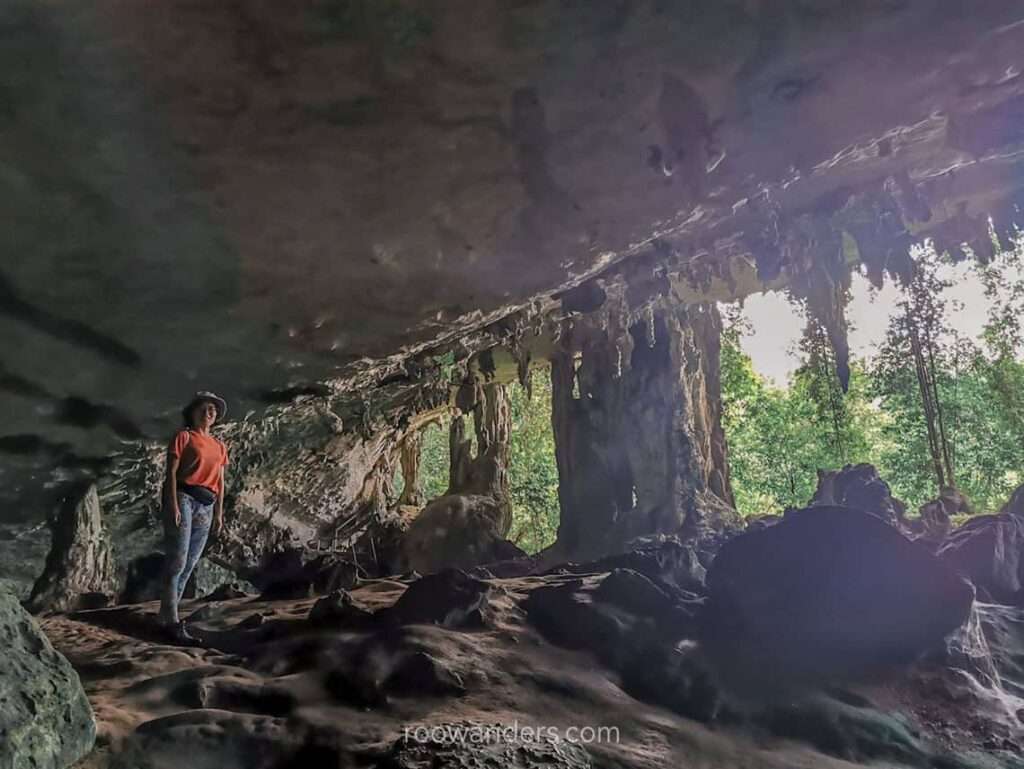
I visited Gua Niah in Jul 2022. This post contains affiliate links that cost nothing to you but support my blog! It may also be updated periodically. As an Amazon Associate, I earn from qualifying purchases. Cheers!
Brief Background of Gua Niah
Gua Niah (Gua means cave), located in the Niah National Park , is an archaeological and natural wonder.
It was nominated in 2021 as a UNESCO World Heritage Site for its evidence of continuous human occupation and early human fossils .
While we did not encounter any burial sites or ancient human remains like that of the Lumiang Cave in the Philippines , the sheer size of the caves – until I visited Deer Cave and Hang Son Doong – was impressive.What made the whole experience even better was the lack of visitors . We were the last to enter and shared the massive site with just a dozen others. More on this later.
Getting To Gua Niah
Gua Niah is about 83 km southwest of Miri. If you’re not in Miri yet, find a bus or flight to get you there.
There are three ways to get there: public buses, rent a car or secure a tour.
Going to Niah Cave via public bus is the cheapest method.
Several sources suggest taking the bus 33A from the City Centre to Pujut Corner Bus Terminal, then switching to the intercity bus towards Bintulu. Halfway through the journey, alight at Niah Rest Stop and grab a taxi to reach the Niah National Park Office.
Bus fare costs RM15 , while the taxi may cost about RM30 .
I have not taken this route, seen any public buses in Miri, or encountered any blog posts sharing this endeavour. But if you do, please message me!
Car rental is affordable in Miri. It costs us RM100 to rent the lower end of their national sedan – Proton – for a day. A full tank costs around RM100 .
Driving in Miri was relatively much more comfortable and relaxed than in Kuala Lumpur or other West Malaysian states – according to my travel buddy, who has lived in KL and JB.
The fastest way from Miri city centre to Niah Cave was via the coastal highway Q642 to Niah town (around 77 km), followed by a short 5 km to the cave.
Make sure you set your Google destination as Niah Cave/ Gua Niah and not Niah National Park . The latter would lead you to the other side of the park, which was what happened to us.
We travelled to Batu town, crossed narrow unpaved and pothole-ridden roads through a village, and found ourselves facing a field overlooking the Niah mountain and the guard regrettably informing us of our error.
But that additional travel and detour time led us to some surprises in Gua Niah as we shall see later 🤩.
Private Tour
If driving is a chore, you could hire a driver. Our Grab driver from Miri International Airport to the city centre quoted RM450 for a day trip. Alternatively, there are tour agencies offering day tours for around RM260 per person, all-inclusive.
Ticket Prices and Opening Hours
If you have no evidence to prove you are a Malaysian, then be prepared to pay double or RM20 for the entrance fee.
Most national parks in Sarawak (including the Miri-Sibuti Marine National Park where we dived ) charge RM20 for foreigners.
The Niah National Park opens from 8 am to 5 pm. The last boat across the river from the cave to the carpark departs at 5.30 pm.
Accommodation in Niah National Park
While we were there, I noticed a block of single-storey buildings behind the Niah National Park museum. Those interested in exploring the trails beyond the caves could stay in the lodges, a hostel or a campsite in the national park.
We rented a sedan and drove to the caves. But we had erroneously set the destination as Niah National Park and not Niah Caves , thinking these were the same. The caves are in the park so we should be right… right ?
Wrong Route
Google Maps had other plans and directed us to the other end of the national park, directly behind the caves!
If you were to take the wrong route, you would drive an additional 30 minutes , cross Batu town, where there are many heavy-weight vehicles, and travel down muddy, pothole-ridden roads that also lead to a village. A jeep – not our lousy Proton sedan – would work better on that road.
Right Route
If you were to pick Gua Niah, congrats. Google Maps would direct you through Niah town, and a short 5 km drive to the gates of the National Park.
After getting our tickets – bring your identification card/ passport – we board a longboat by the river, thinking it would be a fun ride.
Imagine recording the video of the moment, only to realise that the ride was less than a minute and its sole purpose was to bring us across to the other side. At least I have broken your bubble of anticipation.
It costs RM1 for a one-way journey across the river. The last boat service is at 5.30 pm.
Museum and Lodges
Beyond the river bank is the Niah Museum – possibly housing artefacts or educational posters about the cave excavation – and lodges. We skipped those and headed straight for the caves.
The first 3 km to the caves was on a boardwalk – a remarkable amenity for me, considering we were in Malaysia . Most of the treks I have done in the Malaysian peninsula were not as manicured .
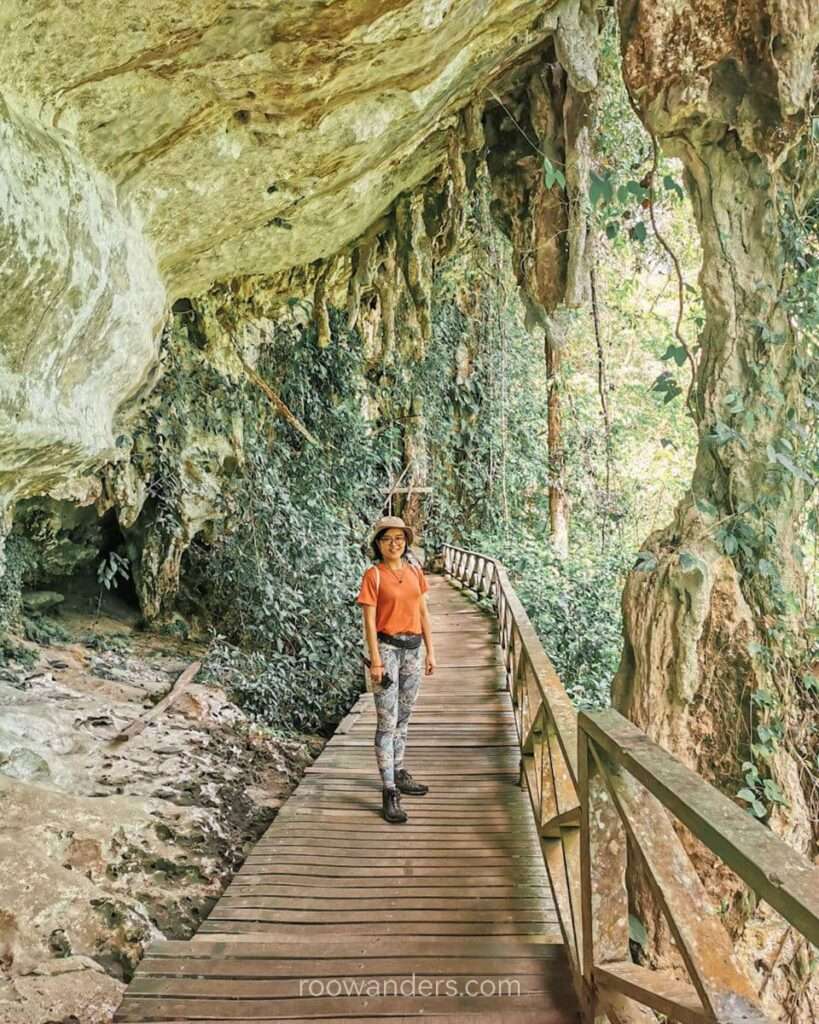
Walking on these combed paths surrounded by the lush primary tropical forest and cacophony of natural sounds somewhat transported me back to MacRitchie Reservoir in Singapore , except you get less human traffic and more brightly-coloured millipedes.
Trader’s Cave
The first cave to the Great Cave welcomed us at the end of the tropical forest plank walk.
Unlike the handful of caves I was blessed to visit, this cave had many supporting wooden beams in the first half of its cavity, lending the space an eerie and dangerous vibe .
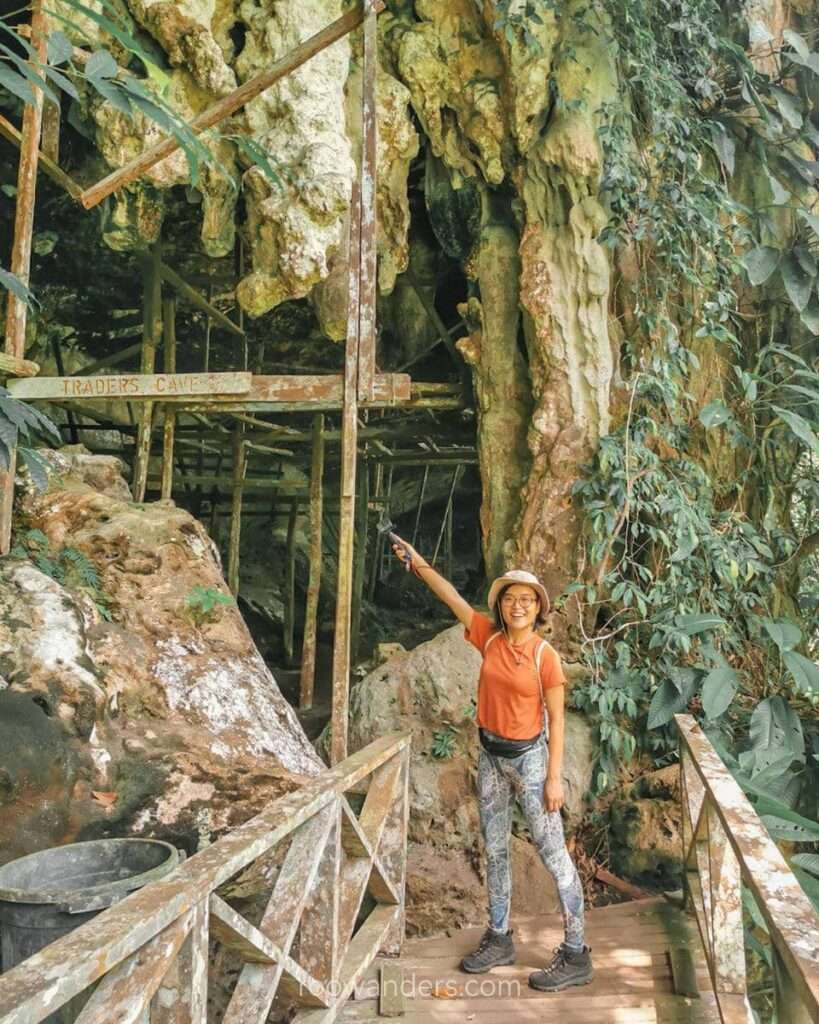
Unlike the handful of caves I was blessed to visit, this cave had many supporting wooden beams in the first half of its cavity, lending the space an eerie and dangerous vibe .
In reality, the Trader’s Cave is more of an extended rock overhang than a true-blue cave, and the beams were supposedly the support of the roofless huts of traders back then.
The wooden supports remain to this day as they are made from Bornean Ironwood , an extremely dense and hard wood that sinks in water.
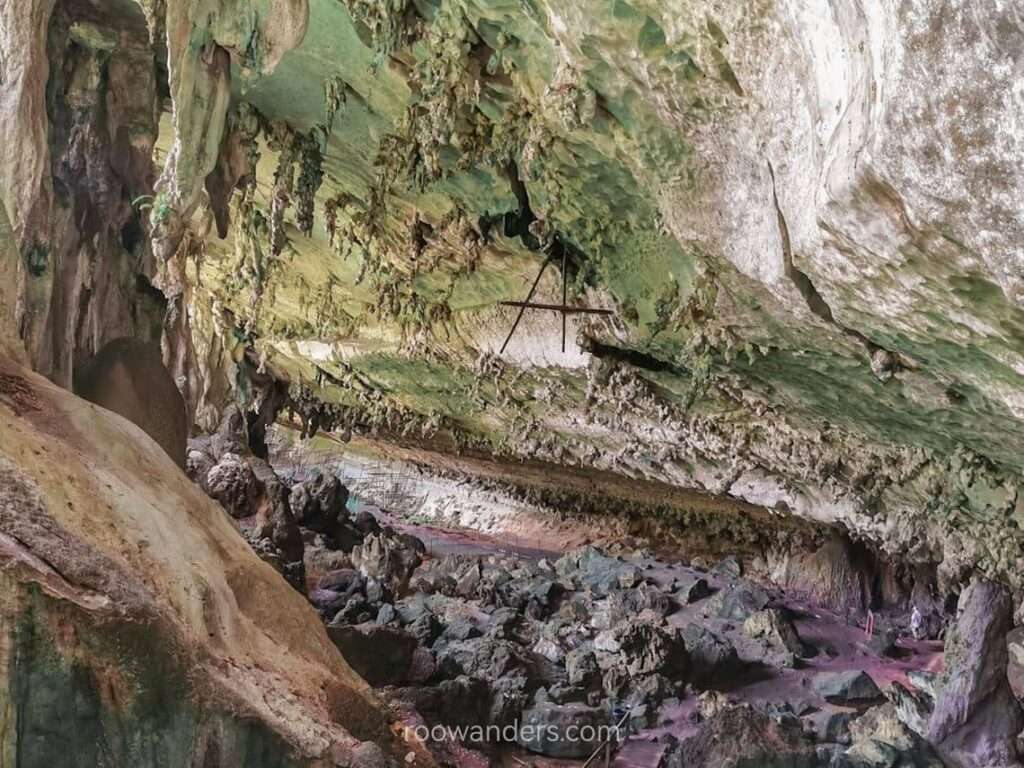
The Trader’s Cave is, as its name suggests, a place where bird-nest traders/ collectors used to live in days gone. These collectors bartered raw birdnest for groceries in their roofless huts.
Evidence of prehistoric human settlement has also been found in this cave , and we saw a cordoned excavation site at the centre of the cave.
If you have not done your homework like my travel buddy, this cave would exceed your expectations. But since you are reading this, I guess it isn’t anymore. Cave researchers enjoyed documenting this cave for its extraordinary karst features and morphology.
Our next cave – the Great Cave – was even better.
A couple of minutes out of the Trader’s Cave over wooden steps led us into the West Mouth of the Great Cave.
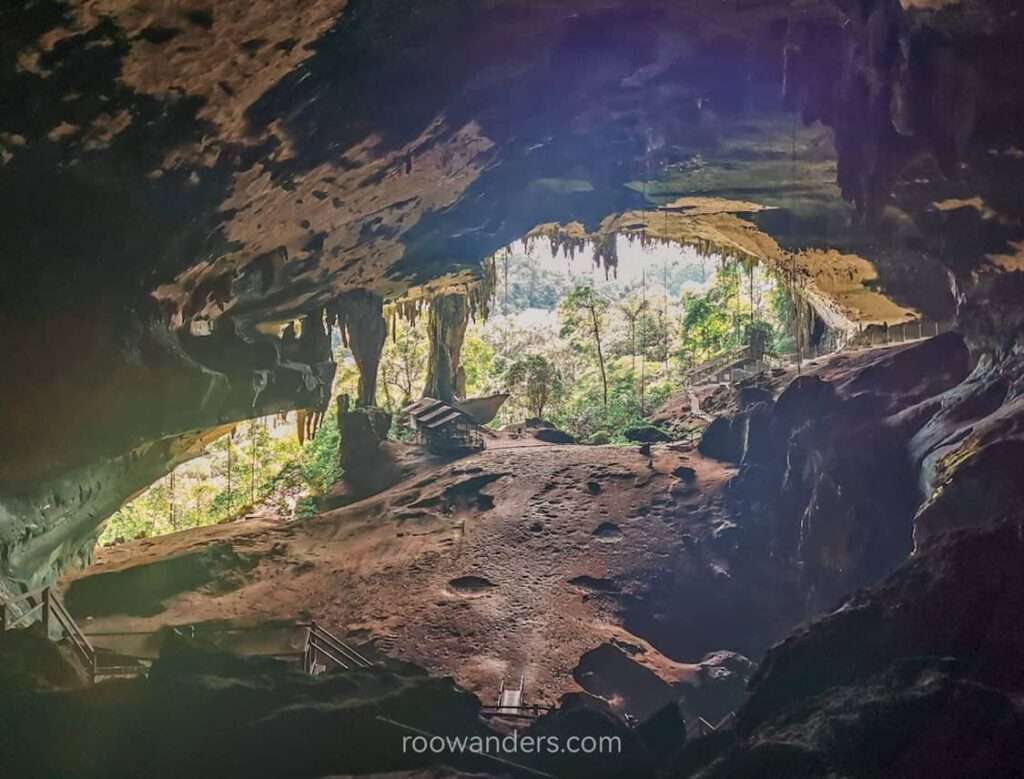
At 60 m high and 250 m wide, its dramatic entrance puts it high up on my amateur list of impressive caves – as with the Waitomo Caves in New Zealand and the Lumiang-Sumaguing Caves in the Philippines . I later visited the largest cave in the world, Hang Son Doong in Vietnam .
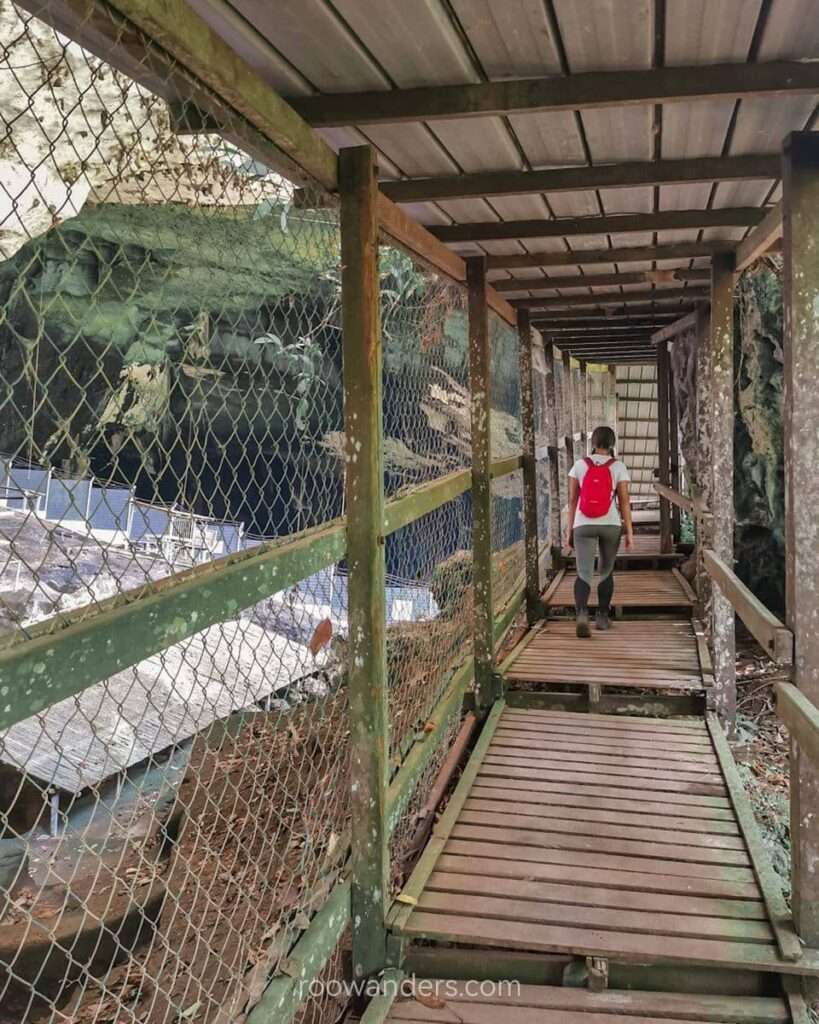
As we walked into its humongous cavity, a portion of the cave to our left was cordoned off for archaeological excavations. This was where researchers first located the oldest human remains in Southeast Asia (SEA), dated more than 40,000 years ago . More reading material about early human fossils in SEA here for your curious perusal.
Within the huge chamber was a replica of Tom Harrisson’s House. Tom and his wife Barbara were the first excavators and the people who discovered the Deep Skull of Niah .
The house, combined with the lack of visitors and the overall ambience, lent it an extremely eerie vibe. Who knows what you may find in the house!
Guano or bats’ poop coated the grounds, colouring the stairs and cave floor a deep brown and an impression that it is slippery. Perched high above us were swiftlets darting in and out of their nests, and colonies of resting bats. Their noises heightened nearing sunset when we rerouted back to the Great Cave.
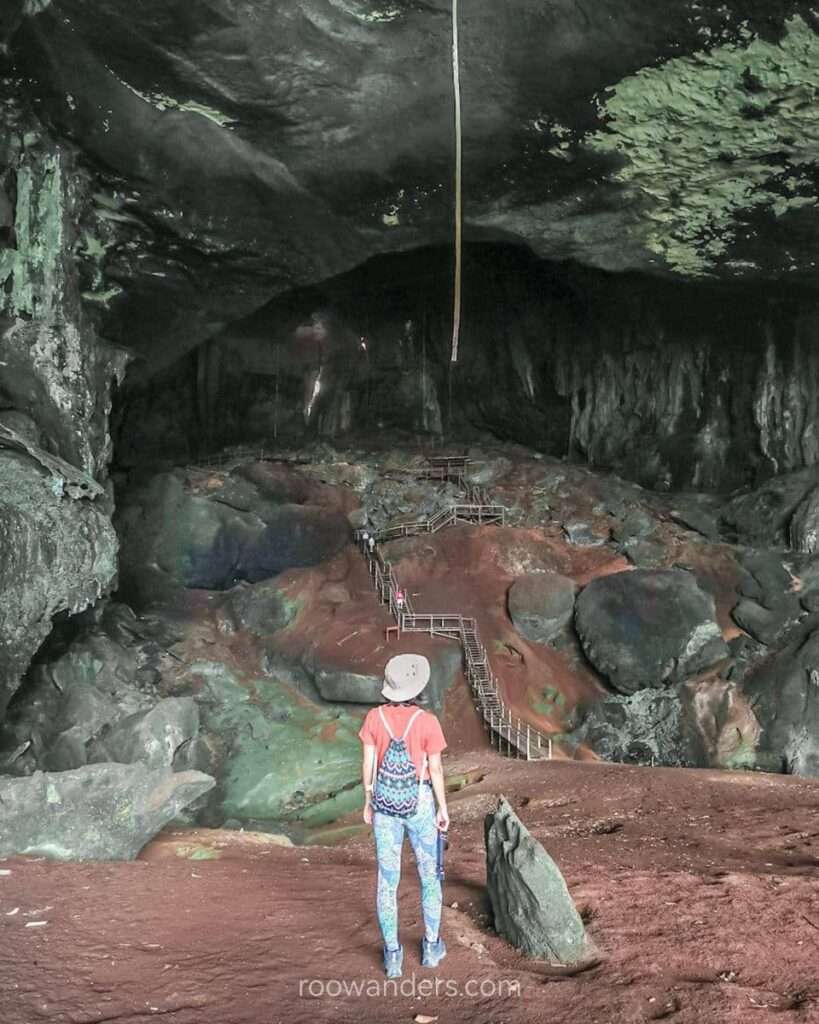
If no one’s around, try whistling or hollering into the Great Cave – it makes for some great echolocation .
As we climbed the guano-covered steps deep into the Great Cave, we encountered several pretty spots for photo-taking. I like to think that the 30-minute delay we faced at the start of our trip led to this timely shot where shafts of the late afternoon sunlight streamed in from a large gaping hole above. That opportunity lasted for a mere 10 minutes. We saw something similar while we were at the Golden Crab’s Cave in Vang Vieng, Laos .
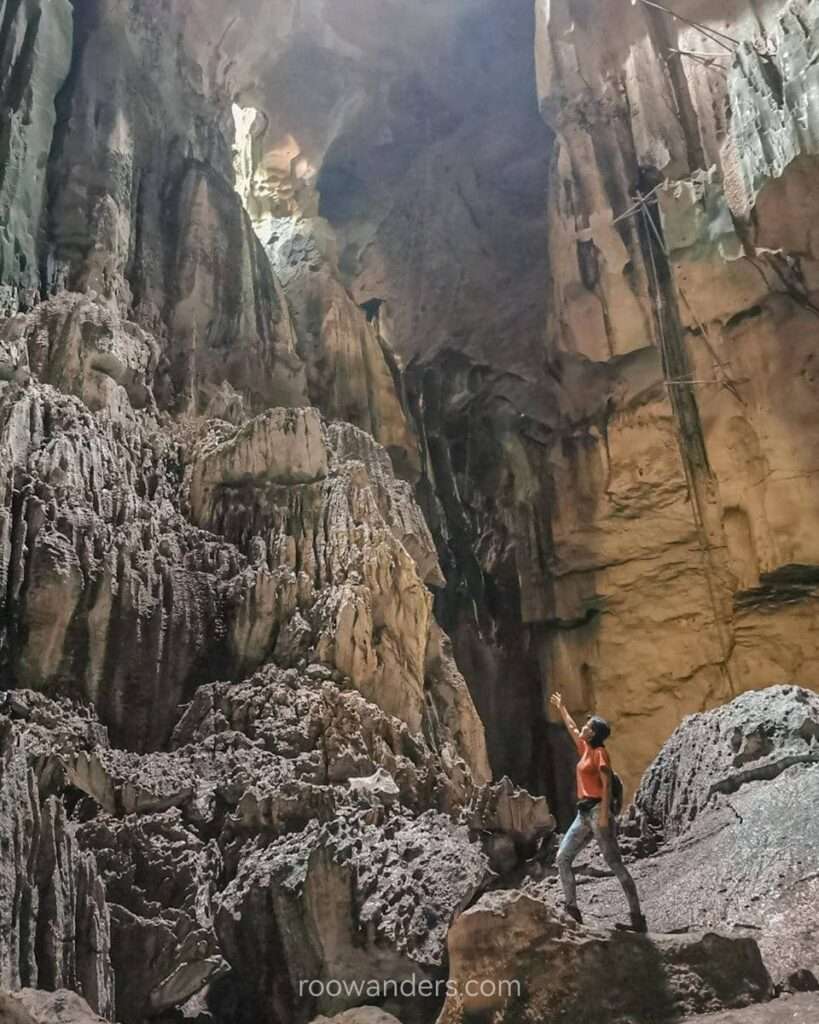
Torchlights or headlamps were critical beyond the Dark Zone , as highlighted by a sign somewhere along the way.
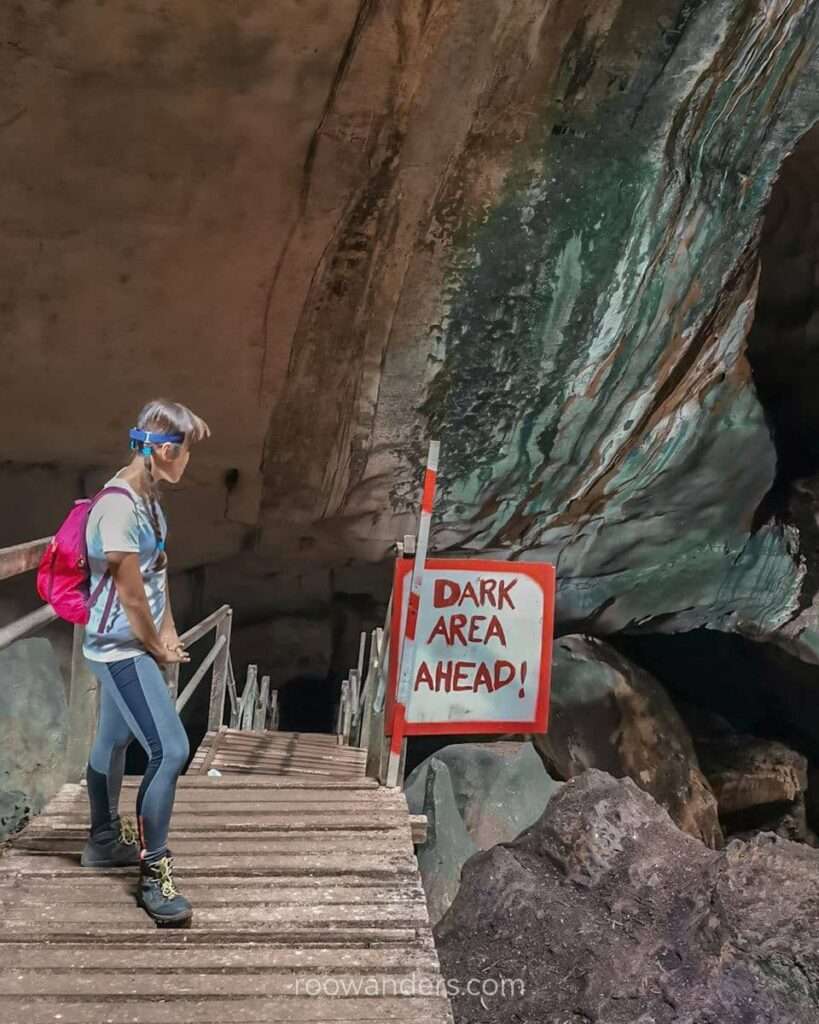
Expect to see lots of large but shy cave crickets in this portion of the cave, as with a smattering of tiny flying insects that like to smash themselves on my headlamp and hence my face.
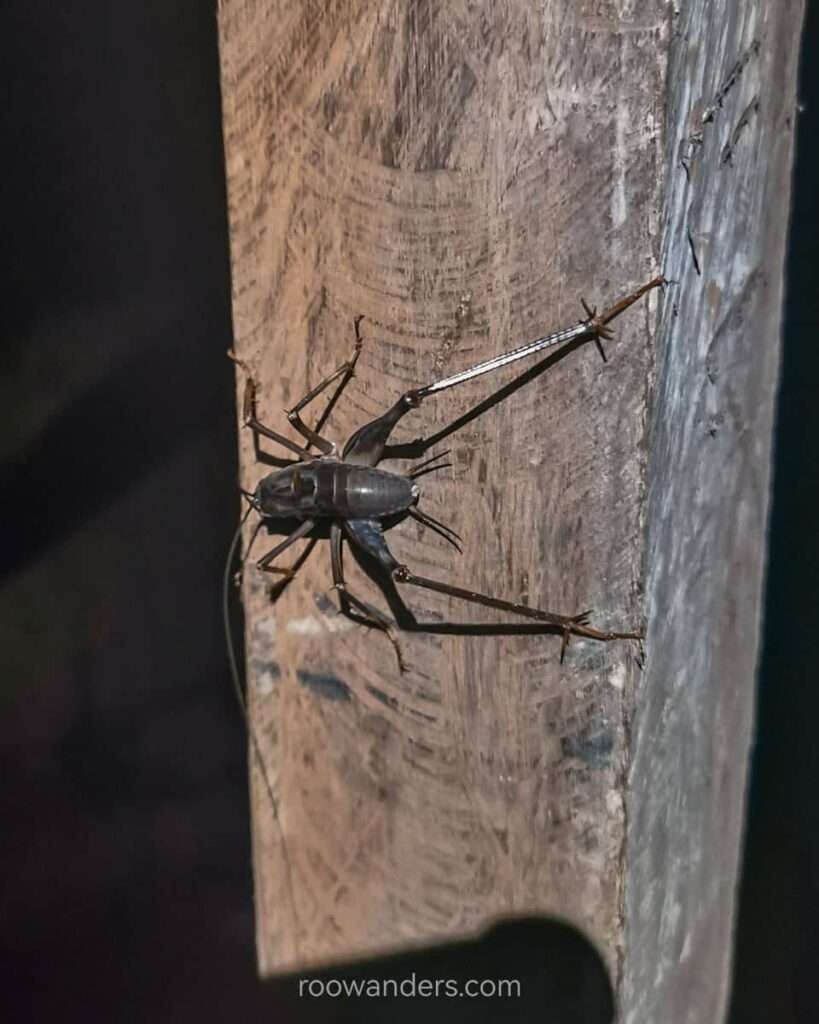
Painted Cave
We exited the Moon Cave and crossed another gate and set of boardwalks towards the Painted Cave.
I found myself underwhelmed by the cave paintings. Blame it on the previous caves.
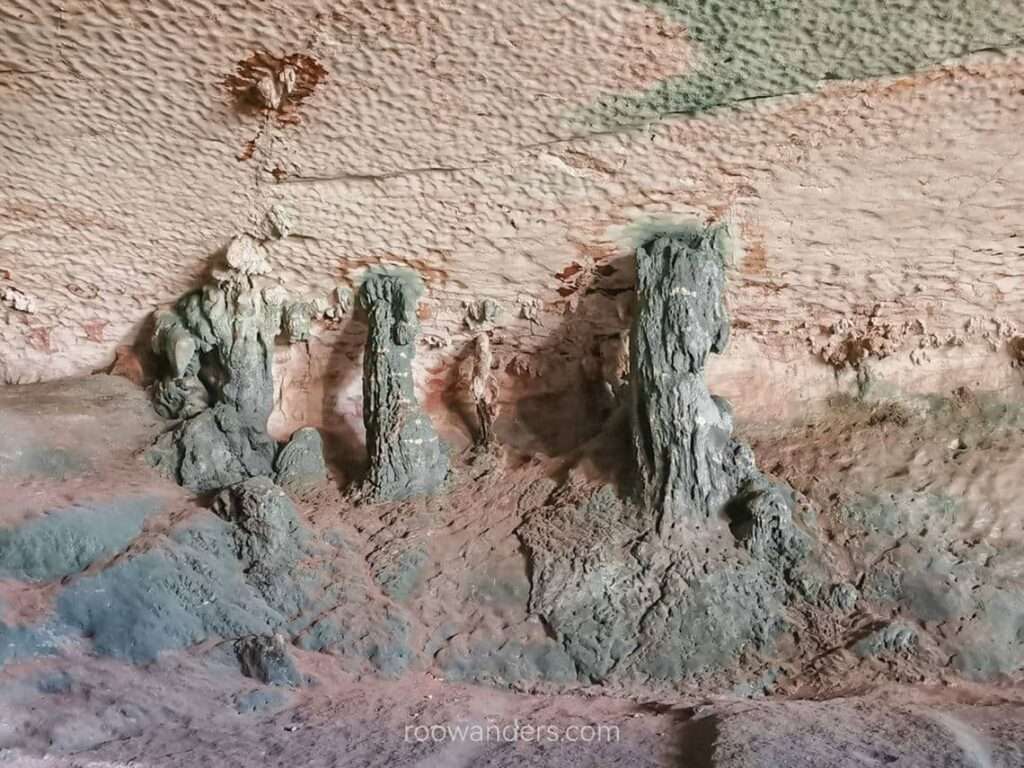
The painted portion of the cave was fenced up, and we had a hard time searching for the paints. Had it not been for my Huawei phone or the cobwebbed educational posters behind the fences, I would have thought the 1,200-year-old paintings non-existent. They were so faint! You can see the photos here in a research paper .
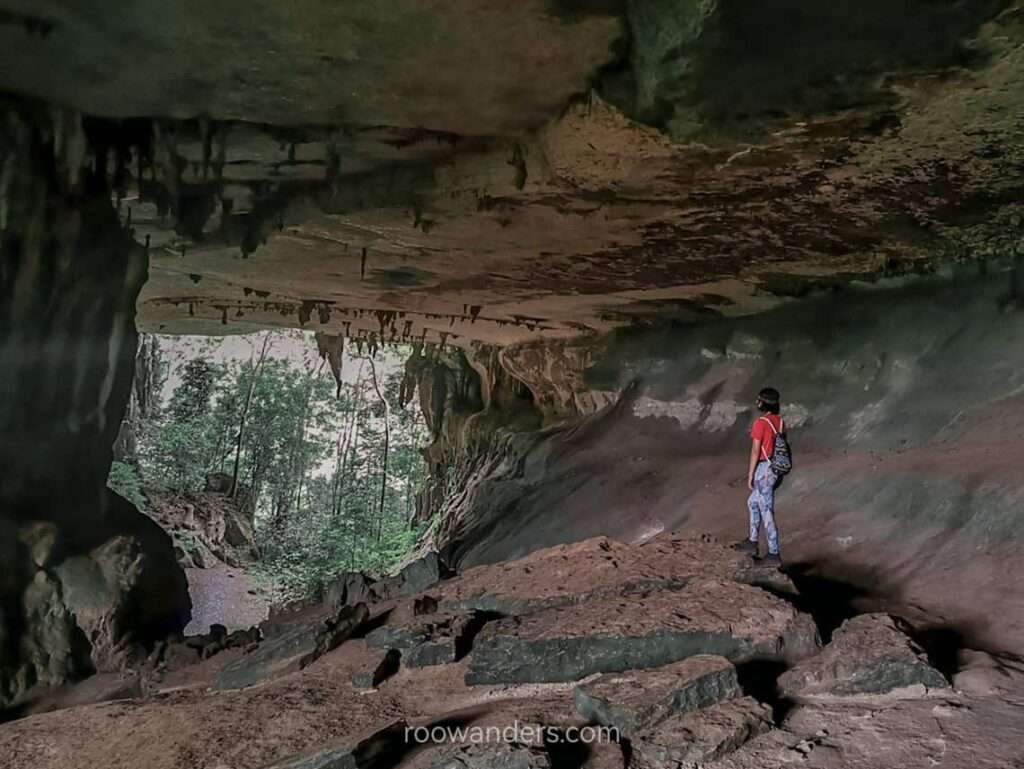
It was almost 4 pm by the time we reached the Painted Cave. We retraced the same way back to the carpark in under an hour to a hot car.
Conclusion/ Rambles
Gua Niah ought to be on your list if you are in Miri and heading to Mulu. Schedule this day trip, preferably before your journey to Mulu National Park to reduce an overdose of caves.
The caves I have visited in Miri and Mulu exhibit different characters. While the caves in Mulu are no doubt impressive, visiting Gua Niah sits differently as this is the only cave you could visit without a guide . Caves in Mulu are much more patronised than Gua Niah and thus have additional light installations and groomed paths, which took away a huge chunk of the sense of adventure.
The overall experience of a self-guided trip in Gua Niah made for an especially memorable journey.
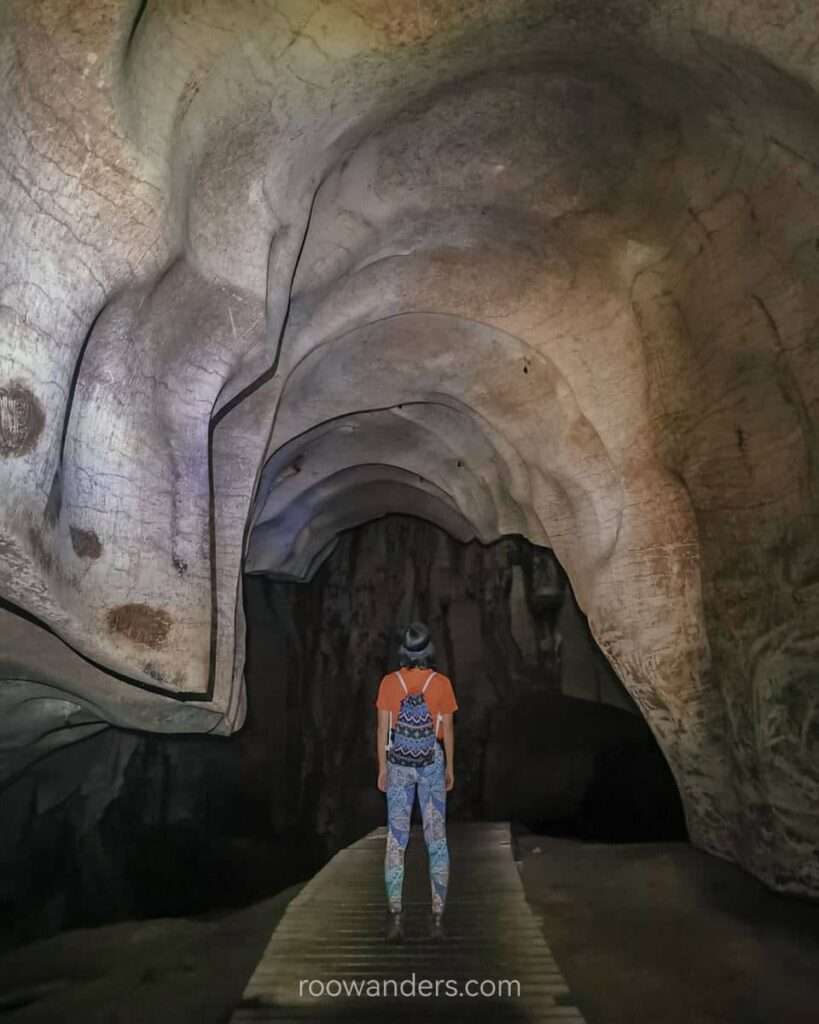
Additional Tips
- Set your locations well. Make sure your destination is Gua Niah and not Niah National Park if you are self-driving.
- Lights up for the caves. Headlamps or torches for the dark areas.
- Visit in the afternoon. Smaller crowds. Read this for our Miri x Mulu itinerary planning!
- Bring hydration. It is a half-day tour and the park is humid.
- Identification card/ passport. You’d need this for the tickets.
- Wear sturdy shoes. The boardwalk, steps and cave floor may be slippery. I wore my Merrell hiking shoes as we planned to hike the Mulu Pinnacles .
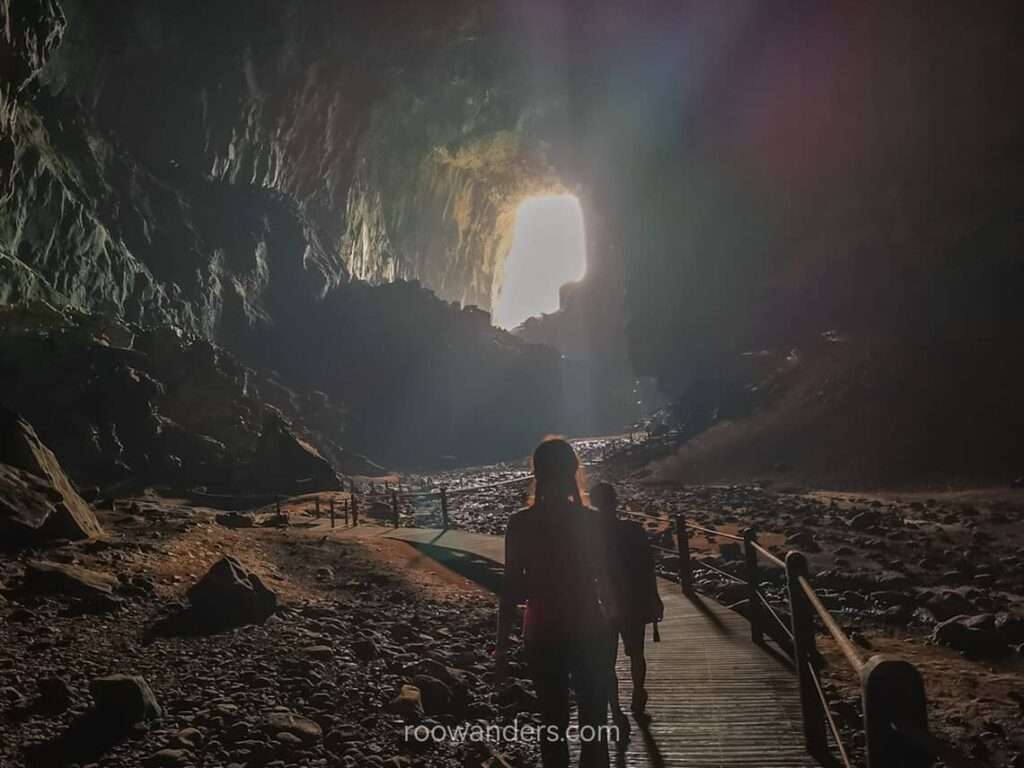
You May Also Like
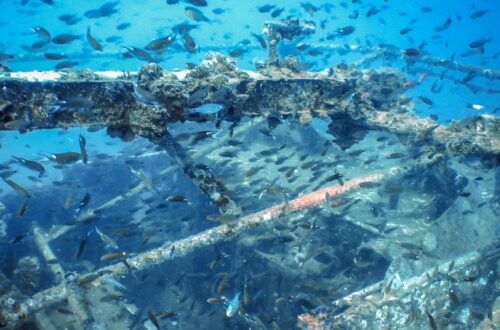
My First Dive in Tioman
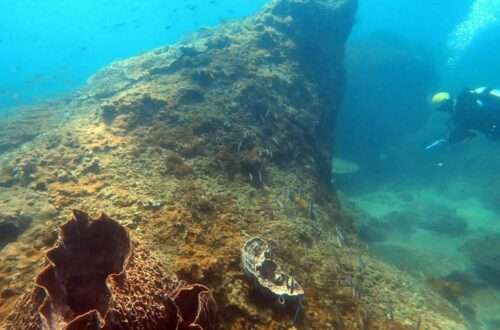
Scuba Diving in Miri-Sibuti National Park
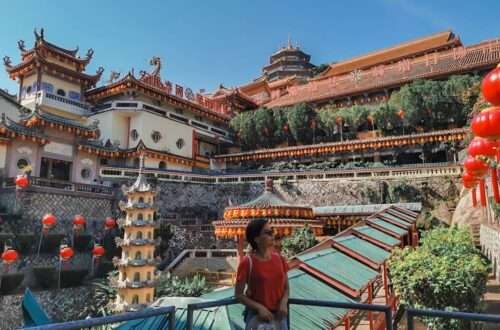
Kek Lok Si Temple: A Jewel of Penang
Leave a reply cancel reply.
Your email address will not be published. Required fields are marked *
Save my name, email, and website in this browser for the next time I comment.
This site uses Akismet to reduce spam. Learn how your comment data is processed .
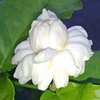
Top ways to experience nearby attractions

Most Recent: Reviews ordered by most recent publish date in descending order.
Detailed Reviews: Reviews ordered by recency and descriptiveness of user-identified themes such as waiting time, length of visit, general tips, and location information.

Also popular with travellers

NIAH CAVES: All You Need to Know BEFORE You Go (with Photos)

Niah National Park
About niah national park.
_______________________
Known for the site where the oldest human remains were discovered in Southeast Asia, Niah National Park has lots to offer to both its day and overnight visitors. The park itself has multiple caves with impressive and archeological sites.
The surrounding area has dense primary rain forest which is home to many species of plants and wildlife. In the evening, visitors get to take a romantic walk in the moonlight and be serenaded by the symphony of sounds from the rainforest.
ENTRANCE FEES
Non-malaysian.
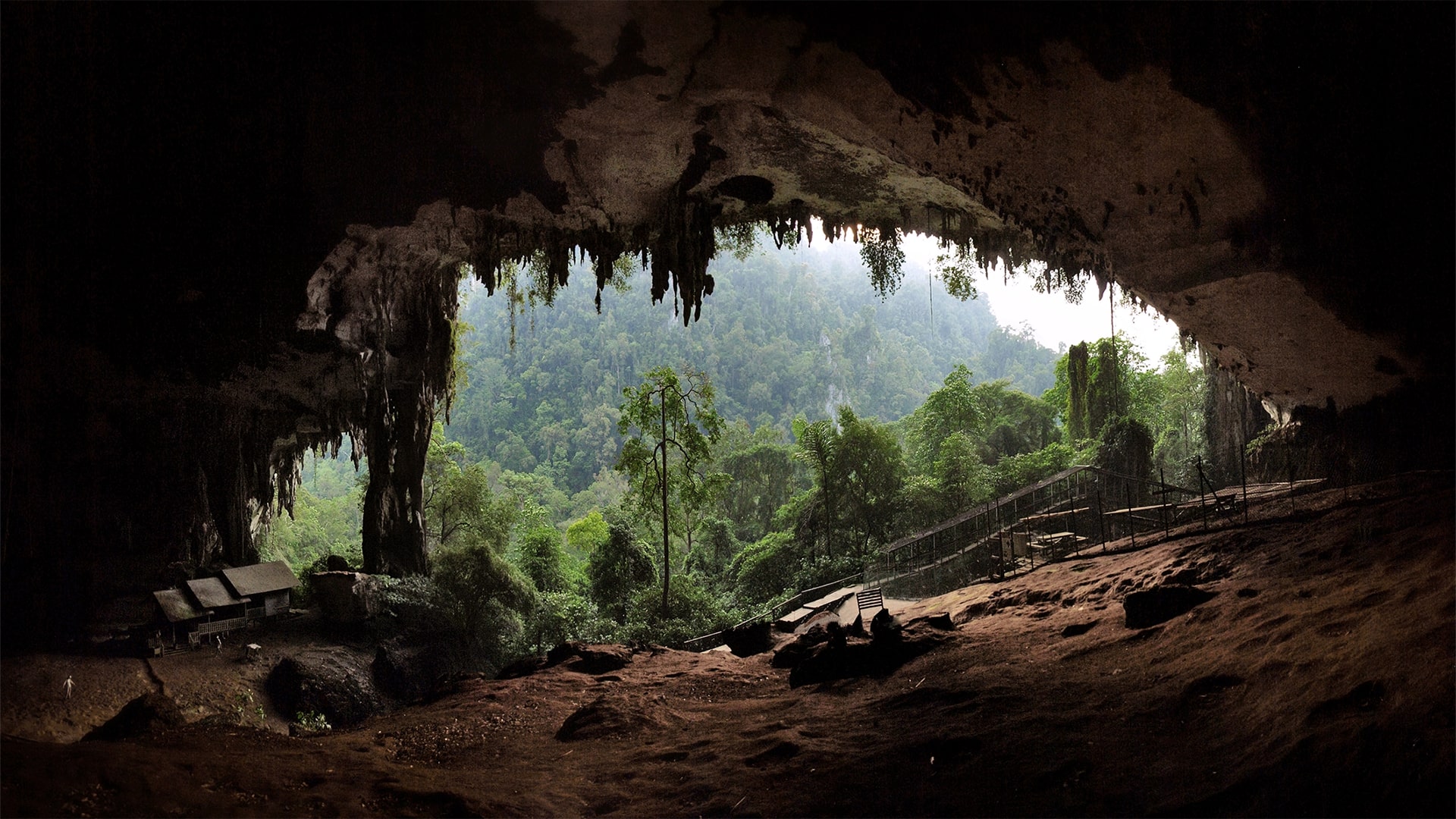
Getting there
Niah cave trail map (inclusive of coastal road).
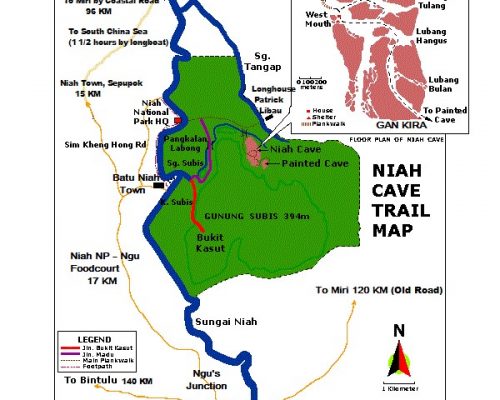
Additional Info:
Traveler can getting there by…
The park headquarters is a two-hour’s drive from Miri or Bintulu either via old road or new coastal road. From the park headquarters you need to cross the Niah River in a motorized boat and then take a one hour walk on a walkway to reach the entrance of The Great Cave. The walkway also links to an Iban longhouse homestay.
Take Bus from the Pujut Corner Bus Terminal, Miri. From here, take any bus heading to Bintulu, Sibu & Kuching. Approximate travel time 1 Hour 30 minutes. Get off at Niah Rest Stop (Ngu’s Junction). From here, take private vehicle to Park Headquarters approximate 17KM/30 minutes’ drive.
Counter Operating Hours :

(Monday – Sunday including Public Holidays) – 8.00am until 5.00pm
Day trip visitors – 8.00am until 3.00pm, overnight visitors – 8.00am until 5.00pm, tel: (+6) 085 737450 / 737454, niah as unesco world heritage your voice can make a difference.

© 2024 Niah National Park. Sarawak Forestry Corporation , Powered by Karuna Web Design
- Attractions
- Accommodation

- Day Trips & Excursions

Historical Niah National Park Day Trip from Miri
- Hotel pickup and drop-off included
- Niah National Park day trip from Miri
- Ride a boat across the river and trek in the forest
- See the Niah cave paintings with an informative guide
Inclusions & Exclusions
- Professional guide
- Local lunch at a park cafe
- Hotel pickup and drop-off (selected hotels)
- Surcharge for pickup and drop-off at Miri Airport
- Camera fee (if applicable, pay directly at venue)
Departure & Return
Hotels located within Miri city center
Returns to original departure point
What To Expect
Meet your guide upon hotel pickup in Miri and embark on a 1.5-hour drive to Niah National Park. Learn about the archaeological site showing evidence of Southeast Asia's oldest human settlement and its main claim to fame: the remains of a 40,000-year-old Homo sapiens skull discovered in the Niah Caves.On arrival, you'll ride a boat across a narrow river and take a tranquil forest hike for roughly one hour to the vast limestone caves, home to bats and swiftlets. See a variety of plant life common to the limestone topography and perhaps encounter birds and other small animals.Venture with your guide into the Niah Great Cave, where you'll see the human skull on display along with tools made of stone, bone and iron. Not to be missed are the Niah cave paintings of boats and human figures. Wooden coffin 'death-ships' were also found here and their prehistoric artifacts are now on exhibit at the Sarawak Museum.After a look, you'll stop at a park canteen for an included lunch before return transport to your Miri hotel.
Additional Info
- Confirmation will be received at time of booking
- No heart problems or other serious medical conditions
- Children must be accompanied by an adult
- A lot of walking is involved; comfortable walking shoes are recommended
- Sightings of wildlife are not guaranteed
- Subject to favorable weather conditions. If cancelled due to poor weather, you will be given the option of an alternative date.
Cancellation Policy
For a full refund, cancel At least 24 hours in advance of the start date of the experience.
Your Contact Details
Questions or requests.
Do you have questions or specific requests regarding this tour?
- --> --> --> --> -->